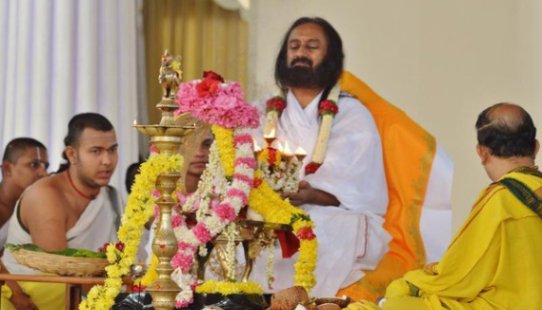Significance of Rudrabhishek or Rudra Puja
Rudrabhishek是一種古老的誦經,是從空間(Aakasha)下載下來的。當古老的聖者和先知Rishis坐著靜心時,他們聽到了,他們聽到後,便開始傳遞給其他人。
Rudrabhishek的作用是產生正能量並消除負面振波。
關於Rudrabhishek的說法很多。當Rudrabishek發生時,自然蓬勃發展,自然變得快樂,幸福。
關於Rudrabhishek的說法很多。當Rudrabishek發生時,自然蓬勃發展,自然變得快樂,幸福。
主要的是振波,就是這樣。如果您問我:「您知道所有讚歌的含意嗎」?
我會說:「我也不知道」。「重要的是讚歌的震波,然後才是意思」。
Rudrabhishek分為兩個部分,第一部分說:「Namo,namo,namo,namo」!’
Mana(法力),意味著心智。
Mind心智這一英文字自梵語「Mana」法力。
Mind心智這一英文字自梵語「Mana」法力。
Nama納瑪是心智的相反。心智走向它的源頭稱為Nama。
當心智走到外面去體驗世界時,那就是Mana(法力)。
而Nama(那瑪)是心智回到源頭。
當來到源頭時,會發現什麼?一切都是同一種意識組成。
現在,今天的科學家怎麼說?上帝的粒子–一切都由此而來。
幾千年前,先知Rishis說了同樣的話,一切都由同一個東西所組成,他們稱梵Bramhan。
–無論是男性還是女性。它不過是 Tattva是原則。
他們稱其為梵Bramhan是構成一切事物的偉大原則。
當梵Bramhan成為個人時,它被稱為希瓦原則(Shiva Tattva)–
天真無邪的神性;那就是一切。
為什麼我們說「Namo納莫,Namo納莫!」’
天真無邪的神性;那就是一切。
為什麼我們說「Namo納莫,Namo納莫!」’
在樹木、綠色植物、鳥類、甚至是小偷中以及任何地方,
它都是相同的原則。
它都是相同的原則。
然後,第二部分會說: 「chame,chame,chame。」您已經聽到了,不是嗎?
這意味著一切都在我之內。
英文中的「Me我」來自梵語「 Ma」,意思是「我自己」。
「Ma Ma」的意思是「為我For Me」、在我之內「In Me」。所以,「一切都在我」。
第二部分是:「一切對我而言,一切對我而言」。
即使是數字,他們說「Ekaachame」,也就是一,二,三,四,它們都是我的形式。
「我」。
這樣,「Sugamchame」,為了我的快樂。
「Abhayanchame」是無畏,快樂,健康,宇宙中所有美好的事物,讓它們都來到我身邊,它們都屬於我。這就對了。
唱誦時,通常是牛奶和水逐滴流過水晶體。這是古老的方法。可以用「水」或在「火」中進行。
他們要做的是保持火勢,為了在不同的讚誦時放不同的草藥。或者,您讓一絲水流不停地流落在水晶上,然後聆聽這種讚誦–這是古老的方法。
在星期一舉行這Rudrabhishek唱頌那就更加特別了。星期一是月亮的日子,月亮和心智相關連。特音、心智、月亮,它們都在某處相連結。因此,在印度,這是一種傳統,他們在靜心所中誦讚。因此,在我們的靜心所中,每個星期一都有舉行這Rudrabhishek。
這五個元素全部用於禮讚pooja。 禮讚意味著尊重所有元素都由「圓滿」而生的。因此,無論大自然給了我們什麼,火、水、香、水果、鮮花、大米,這些東西都會在誦讚進行時被用到。它有很多更深度的和意義。您可以去做一些搜尋/研究,結果將會越來越多。
主要是,它會產生更多的正離子,人們在靜心時也會產生更多的正離子。僅僅將其作為一種儀式並沒有那麼有效,
據說當人們從內在覺醒時,吠陀唱頌是具有效力的。
對他們而言,這些特音具有更多的意義。
因此,它們可以幫助您深入靜心。
Rudrabhishek is an ancient chanting which was downloaded from the Aakasha (space). When the ancient sages and Rishis sat in meditation, they heard, and what they heard, they started transferring to other people.
據說當人們從內在覺醒時,吠陀唱頌是具有效力的。
對他們而言,這些特音具有更多的意義。
因此,它們可以幫助您深入靜心。
Rudrabhishek is an ancient chanting which was downloaded from the Aakasha (space). When the ancient sages and Rishis sat in meditation, they heard, and what they heard, they started transferring to other people.
The effect of Rudrabhishek is it creates positive energy and removes negative vibes. And a lot is said about the Rudrabhishek. When Rudrabishek happens nature flourishes, nature becomes joyful, happy.
Main thing is the vibration, that is it. If you ask me, ’Do you know the meaning of all the chants? I will say, ’I also don’t know.’ It’s the vibration of the chants that is important and then the meaning.
There are two parts, the first part says, ’Namo, namo, namo, namo!’
Mana, means mind. The word mind in English comes from Sanskrit word Mana.
Nama is the reverse of the mind. The mind going to its source is called Nama.
When the mind goes outside to experience the world, it is Mana. So Nama. is the mind going back to its source.
When it goes to its source, what does it find? Everything is made up of one consciousness.
Now, what do the scientists today say? God Particle – by which everything has been made. Thousands of years ago the Rishis said the same thing, that everything is made up of one thing, and that they called Brahman. – that which is neither male nor female. It is nothing but a Tattva. Tattva means principle.
A great principle by which everything is made of, they called it Bramhan. And when thatBramhan becomes personal, it is called Shiva Tattva – the innocent Divinity; that is in everything. That is why we say, ‘Namo, namo!’
A great principle by which everything is made of, they called it Bramhan. And when thatBramhan becomes personal, it is called Shiva Tattva – the innocent Divinity; that is in everything. That is why we say, ‘Namo, namo!’
In the trees, in the greenery, in the birds, even in the thieves, and in a dacoit, everywhere, it is the same one principle.
Then, the second part will say, ‘Chame, chame, chame, chame.’ You have heard this, isn’t it?! This means, everything is in Me.
‘Me’ in English comes from the Sanskrit word ’ Ma’, which means Myself.
‘Ma Ma’ means ’ For Me’, ‘In Me’. So, everything is in terms of ; myself;. The second part is everything is for me and everything is in terms of me.
Even for numbers they say, ‘Ekaachame’, which means, one, two, three, four, they are all my form; Myself. Like that, ‘Sugamchame’, happiness for me!
‘Abhayanchame’, fearlessness, happiness, health, all the good things in the universe, let them all come to me, and they are all part of me. That is it.
‘Abhayanchame’, fearlessness, happiness, health, all the good things in the universe, let them all come to me, and they are all part of me. That is it.
And as this is being chanted, usually milk and water runs through the crystal, drop by drop. This is the ancient method. It is done with water or in fire as well.
What they do is they keep a fire and they put different herbs for the different chants.
Or you allow a string of water to keep falling on a crystal and you listen to this chanting – this is the ancient method.
Or you allow a string of water to keep falling on a crystal and you listen to this chanting – this is the ancient method.
And done on Mondays it is even more special. Monday is the day of the moon and the moon and mind are connected. Mantra, mind, moon, they are all connected somewhere. So, in India, it is a tradition, they have this chanting going on in the Ashrams. So in our ashram also, every Monday, we have this.
All the five elements are used in pooja. Pooja means honoring all the elements, born out of fullness. So, fire, water, incense sticks, fruits, flowers, rice, whatever nature has given to us, those things are used and the chanting goes on.
There is a lot of depth and meaning to it. You can go and do some research on it, more and more things will come out.
Mainly, it creates more positive ions, more so when people are meditating.
Just doing it as a ritual is not that effective because it is said that the Veda Mantras are effective when people are awake from within; for them, these mantras have more meaning. So, they help you to go deep into meditation.
significance-rudrabhishek-rudra-puja/ ( 原文出處的連結)
http://www.srisriwisdom.org/index.php/TW/daily-satsang-tc/4390-wssstd-beopenminded-tc
significance-rudrabhishek-rudra-puja/ ( 原文出處的連結)
http://www.srisriwisdom.org/index.php/TW/daily-satsang-tc/4390-wssstd-beopenminded-tc



沒有留言:
發佈留言